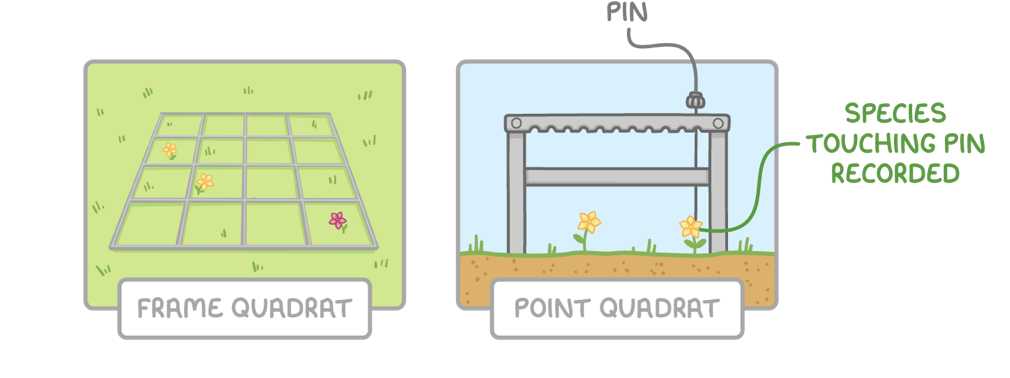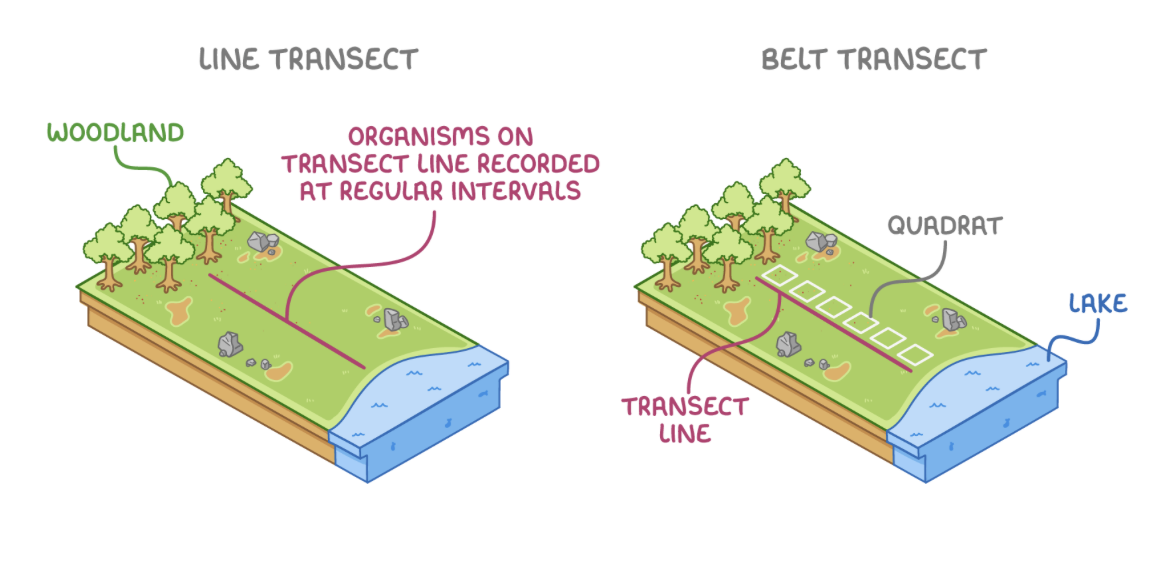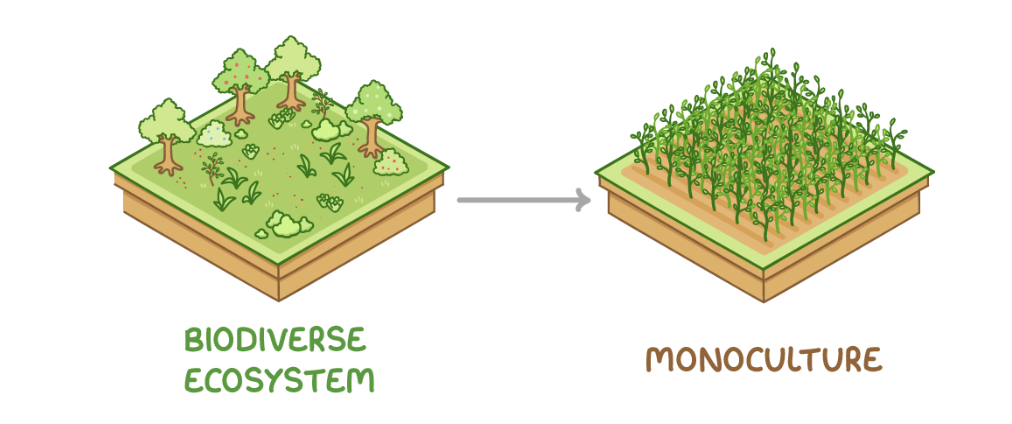Biology:Biodiversity-Species diversity
1/30
There's no tags or description
Looks like no tags are added yet.
Name | Mastery | Learn | Test | Matching | Spaced |
|---|
No study sessions yet.
31 Terms
What is biodiversity
Biodiversity refers to the variety of organisms in an area.
Levels of biodiversity:
Habitat diversity - The number of habitats.
Species diversity - The number of species and the number of individuals in each species.
Genetic diversity - The variation in alleles within a population of a species.
High genetic biodiversity allows for better adaptation to a changing environment and resistance to disease.
Key terms related to biodiversity
Species - A group of organisms that can interbreed to produce fertile offspring.
Habitat - The place where a species lives within an ecosystem.
Species richness and species evenness
Species richness and species evenness are measures of biodiversity.
Species richness:
The total number of different species in a habitat.
It is quantified by taking random samples and counting the species present.
A higher species richness indicates greater diversity.
Species evenness:
A comparison of the numbers of individuals of each species in a community.
It is measured by taking samples and counting individuals of each species.
More even abundances mean higher species evenness and diversity.
11.2 Random sampling
11.2 Random sampling
Random sampling
It is often impractical or impossible to measure every single individual when investigating population traits. Random sampling is important to avoid bias and ensure the samples are representative of the whole population.
How random sampling works:
Choose an area.
Randomly generate coordinates across the area - This prevents sampling bias by removing human involvement in choosing samples.
Collect samples from random coordinates - This gives us samples that are representative of the population.
Repeat this several times - This gives us a large sample size and minimises the effects of chance.
Analyse the data collected - This lets us identify any relationships.
Random sampling techniques (animals)
Pooter - This samples small insects by sucking air containing the insects into a plastic container via a tube.
Sweep net - This samples insects in long grass or air, where the net is swept in a 'figure of eight' motion.
Pitfall trap - This samples small, ground-crawling animals like insects and spiders by catching them in a hidden trap.
Tree beating - This samples the invertebrates living in a tree or bush by shaking or beating the tree to dislodge insects onto a white sheet below.
Kick sampling - This samples river organisms by kicking a river bank and catching organisms downstream in a net.
Sampling plants and non-motile animals using quadrats
A quadrat is a frame used to sample the organisms in an area. They are typically used to sample plants, or animals that don’t move around much (non-motile animals).
There are two types of quadrat you can use:
Frame quadrat - This is a square frame divided into a grid. The type and number of species within each section of the quadrat is recorded.
Point quadrat - This is a frame with a horizontal bar, through which pins are pushed at set intervals to touch the ground. Each species the pin touches is recorded.$

11.3 Non-random sampling
11.3 Non-random sampling
Random and non random sampling
Non-random sampling involves selection based on specific criteria or patterns and the sample is not chosen at random.
Differences between random and non-random sampling:
Random sampling removes human bias in sample selection, improving reliability.
Non-random sampling does not use random selection so is prone to bias.
Types of non-random sampling
There are three main types of non-random sampling.
Opportunistic:
This uses conveniently available organisms.
It may not be representative of the population.
Stratified:
This divides the population into subgroups (strata) based on a characteristic.
A random sample is taken from each subgroup/stratum.
The number of samples taken in each stratum is proportional to the size of the stratum.
Systematic:
This samples different areas in a habitat separately at regular intervals to avoid bias.
Line transects and belt transects
Transect sampling is a method of studying the distribution of organisms in a specific area. It is typically used in systematic sampling.
Transect sampling:
Mark a line (transect).
Take samples along this line at regular intervals.
This lets us study how species' distributions change across different areas within a habitat, like from a woodland to a lake.
There are two main types of transect sampling:
Line transect - Samples are taken at regular intervals along a line between two points.
Belt transect - Samples are taken in an area along a line or between two parallel lines, by using quadrats placed either side by side (continuous) or at regular intervals (interrupted).

Measuring abiotic factors
Abiotic factors directly affect the distribution of organisms in a habitat, so they are useful to measure when sampling.
We can measure abiotic factors like:
Light, humidity, and temperature (using sensors).
pH and wind speed (using probes).
Dissolved oxygen (using specialised probes).
Advantages of measuring abiotic factors:
They can detect rapid changes.
They can reduce human error in taking readings.
They can achieve a high degree of precision
They allow data to be stored and tracked on a computer.
Investigating the effect of abiotic factors on distribution
For example, there may be seashore vegetation gradients based on shell deposit acidity, where the pH is lower closer to the sea due to rotting organic matter.
This could be investigated by:
Placing the transect line perpendicular to the shore.
Taking quadrat samples at regular intervals.
Recording the percentage cover of the target species.
Measuring the environmental variable (e.g. pH) at regular intervals.
Producing a graph of the data and analysing the relationship.
11.5 Biodiversity:Genetic biodiversity
11.5 Biodiversity:Genetic biodiversity
How to assess genetic biodiversity
Genetic biodiversity can be assessed by calculating the percentage of gene variants (alleles) in a genome within isolated populations.
A high genetic biodiversity means there is a large variety of alleles in the population's gene pool. This increases a population's ability to adapt to environmental changes, and so helps them avoid extinction.
How genetic biodiversity can change
Genetic diversity is not static. It can increase or decrease in populations and species over time.
Genetic biodiversity of a population can be increased by:
Gene flow - This is interbreeding between different populations, introducing new alleles.
Mutations in the DNA of an organism - This creates new alleles.
Genetic biodiversity of a population can be decreased by:
Selective breeding - Humans choose organisms with advantageous characteristics to breed (e.g. for rare dog breeds).
Captive breeding programmes - A small group of individuals are bred in captivity.
Artificial cloning - Using asexual reproduction to artificially produce large numbers of a particular (e.g. cloning crop plants).
Natural selection - Species evolve and advantageous characteristics increase in a population.
Genetic bottlenecks - A sudden decrease in population size means only a few individuals remain.
The founder effect - A few individuals form a new population split from the original one.
Genetic drift - Alleles are randomly passed through generations and some may disappear by chance.
11.6 Human impact on biodiversity
11.9 Human impact on biodiversity
Human population growth and biodiversity
The human population has increased rapidly, which has negatively impacted global biodiversity.
Some impacts of the growing human population on biodiversity include:
Deforestation for development destroys habitats and reduces ecosystem diversity.
Overuse of resources causes certain species to decline or go extinct, reducing genetic and species diversity.
Urban sprawl isolates wildlife populations, limiting breeding and decreasing genetic diversity.
Pollution kills species directly and harms habitats long term.
Agricultural practices that reduce biodiversity
Farming methods aimed at maximising crop yields, such as creating monocultures, often decrease biodiversity. These practices decrease habitat, plant, and animal diversity. Populations decline as species lose food, shelter, and breeding sites.
Some of these methods include:
Monocultures - This involves growing single crops over large areas, typically without crop rotation, directly decreasing the diversity of plants and of species that depend on them for food or a habitat. Monocultures also deplete the nutrients from soil.
Converting woodland and hedgerows into fields - This decreases numbers of trees and other species, and destroys habitats relied on by many species.
Filling in ponds, draining marshes, over-grazing of land - This directly destroys habitats and reduces species diversity.
Removing weeds with herbicides - This may harm other species or those that depend on target species.
Using pesticides to kill crop pests - This may harm other species or those that depend on target species.
Using inorganic fertilisers - These may runoff into water courses, causing issues for aquatic species.

Balancing conservation and agriculture
Some methods can help balance conservation and agriculture.
Some of these methods include:
Maintaining hedgerows.
Reducing pesticide and herbicide use.
Using organic fertilisers.
Using crop rotation.
Impacts on climate change on biodiversity
Burning fossil fuels releases greenhouse gases, causing global warming. Climate change alters regional climates around the world. This can cause shifts in the biodiversity in various habitats.
Effects of climate change on biodiversity:
Different regions experience changes in temperature and rainfall, and most species are adapted to specific climates.
Changed conditions will make certain areas more or less habitable in general.
Suitable habitats for some species will expand or contract e.g. melting polar ice caps removes a habitat for all polar animals.
Changing climate conditions may influence species distribution and migration.
Slow-moving species may become extinct if change is too rapid or severe.
If conditions in general become warmer, tropical diseases will be more likely to spread.
Rising sea levels may lead to more frequent flooding of terrestrial habitats in low-lying land.
11.7 Maintaining biodiversity
11.7 Maintaining biodiversity
Ecological reasons
Maintaining biodiversity is vital for healthy, functioning ecosystems, due to the complex interdependencies within them.
Ecological reasons for conserving biodiversity:
Food webs rely on multiple species, so declines in certain species can disrupt food chains.
Losing keystone species that have disproportionately large effects on their environments destabilises these ecosystems.
Nutrient cycles depend on decomposers recycling matter like carbon, nitrogen, sulfur, and phosphorous through ecosystems.
Provides resilience to a changing climate, other abiotic stresses, and disease.
Economic reasons to maintain biodiversity
Diverse ecosystems can support industries by immediately providing useful products, or mechanisms for protecting future profits.
Some products that diverse ecosystems directly provided to the economy include:
Renewable energy and fuel source production.
Industry and raw material compounds like timber, fabric, latex, biofuels, and pesticides.
Many medicines (like aspirin or morphine) originate from living organisms.
Wildlife and natural scenery is a source of income for many countries through tourism (ecotourism).
Microorganisms are the source of many useful products, including antibiotics.
Protecting genetic diversity supports future industries and the economy by providing:
Gene sources for future medicines and products that have not yet been discovered.
Resilience against a changing climate, other abiotic stresses, and disease to economically useful organisms.
Agricultural reasons to maintain biodiversity
Agriculture is vastly important to the world's economy, and to the general survival of the human population by providing food.
Monocultures that repeatedly grow single crops deplete soil nutrients. This is bad for agriculture, and therefore bad for the economy.
Monocultures can cause:
Lower crop yields.
Reliance on expensive fertilisers.
Overall reduced farm productivity.
Promoting diverse ecosystems in agricultural settings and preventing the use of monoculture can therefore be economically beneficial.
Some other agricultural reasons for maintaining biodiversity include:
The wild relatives of cultivated crops provide the genetic resources to widen the genetic diversity of cultivated crops, allowing new varieties of crops with desired traits to be bred.
Genetic diversity provides a safeguard against diseases or pests.
Many crop plants rely on insect pollinators to reproduce.
Aesthetic reasons for conserving biodiversity
Conserving biodiversity has aesthetic benefits.
These include:
Enriching our environment and providing inspiration for musicians, artists, photographers, poets, and writers.
Helping people recover from stress and injury.
11.8 Conservation
11.8 Conservation
In situ conservation of species
Conservation is the preservation and careful management of the environment and of natural resources. In situ conservation protects species in their natural habitats.
Some methods of in situ conservation include:
National parks and wildlife reserves.
Controlling invasive or threatening species.
Protecting food sources and nesting sites.
Making hunting of certain species illegal.
Marine conservation zones.
Advantages of in situ conservation include:
Larger populations can be sustained.
More chance of recovery than ex situ conservation.
But species remain at risk from things like climate change.
Ex situ conservation through relocation
Ex situ conservation relocates species facing imminent threat.
Some methods of ex situ conservation include:
Relocating species to safer regions.
Relocating species for captive breeding, research, and to education centres like zoos or botanic gardens.
Storing seeds in seed banks.
Reintroducing species once populations are stable.
Captive animals may struggle to survive when reintroduced into the wild because of potential loss of resistance to local diseases, behavioural issues, genetic differences, and limited suitable habitat.
International conservation agreements
International cooperation protects migrating species through agreements.
The Rio Convention on Biological Diversity:
Aims to develop conservation strategies and sustainable use of resources.
Made biodiversity conservation an international legal responsibility.
Aims to stabilise greenhouse gas concentrations, and prevent the transformation of fertile land into desert.
Provides governments guidance on protecting habitats.
CITES:
Makes trading endangered species internationally illegal.
Regulates trade of wild plant and animals and their products (like furs, skins, and ivory) through licensing requirements.
Raises awareness through education on threats.
IUCN:
Aids in securing international conservation agreements.
Publishes the IUCN Red List of Threatened Species, detailing the conservation status of threatened species.
These legally binding agreements regulate human activities and make species and habitat conservation a globally shared responsibility. Consistency across borders is vital as at-risk organisms can migrate between countries.
Local conservation agreements
Local habitat conservation schemes can help to protect species. For example, the UK's Countryside Stewardship Scheme subsidises farmers to manage land sustainably. This enhances and conserves the landscape, making conservation a part of normal farming and land management practice.
Some of the actions the scheme subsidies include:
Allowing field margins with natural re-growth.
Protecting hedgerows.
Grazing control.
Supporting local participation preserves special regional habitats.